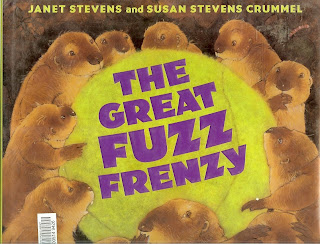Bibliographic Citation
Stevens, J., & Crummel, S. (2005). The great fuzz frenzy. New York: Harcourt, Inc.
Summary
Violet, a large brown dog, drops her green fuzzy tennis ball down a hole which was the home of many prairie dogs. Little Pip Squeak was the first to touch the ball and a piece of fuzz got caught in his claw and so he put it on his head. This started the frenzy of all the prairie dogs having to have some green fuzz. The fuzz news spread to the other prairie dog homes and soon the tennis ball was naked. Then their was a battle and all the prairie dogs became exhausted and fell sleep except one. Big Bark had stolen all the fuzz and jumped out of the hole. An eagle swooped down and picked Big Bark up, but he wiggled free from the fuzz. All the prairie dogs caught him when he fell and they all escaped into the hole. They were happy the green fuzz was gone. But Violet is returning with an orange fuzz ball to drop in the prairie dog hole.
Impressions
This is a great picture book with great illustrations. If a child did not know what a prairie dog was they could tell much about the kind of homes they have. There were several pages that pull down so the reader can tell that the homes go way down in the ground. Of course the prairie dogs are fictional since they talk and fight about the green fuzz. It is a great way to show how a writer can imagine what might happen to prairie dogs if their home was invaded by just a ball.
Suggestions For Use in a Library
1. It is great for discussion on how many ways the prairie dogs used the green fuzz.
2. If a class was studying desert areas and what kind of animals might live in a dry climate.
3. Count the prairie dogs
4. Exclamation words and good vocabulary such as frenzy.
Reviews
PreS-Gr 2-- It all begins innocently enough, when Violet the dog drops a fuzzy green tennis ball down a prairie-dog hole on the title page. When it finally lands deep in the underground tunnels, dozens of little dogs are gazing at it with trepidation. The biggest prairie dog of all, the bully Big Bark, comes to take a look, but before he can get close enough, Pip Squeak runs up to the ball and exclaims, "'It's fuzzy!'" "'Oooooooh!'" gasped the other dogs. Soon, they all begin adorning themselves with pieces of lime-green fuzz, ignoring Big Bark's commands that they stop this foolishness. Prairie dogs come from all over to help themselves until the ball is plucked bare. War breaks out, leaving Pip Squeak feeling rather guilty for starting it all. While the embattled dogs collapse in exhaustion, Big Bark steals all of the fuzz, proclaiming himself "king of the fuzz," which makes him an easy target for an eagle, who swoops down and grabs him. Pip Squeak rallies the others to come to Big Bark's aid. The marvelously rendered mixed-media illustrations, with vivid blues, earthy browns, and that luminescent green, capture the true fuzzy nature and greenish glow of the ball. As in the author's popular Tops and Bottoms (Harcourt, 1995), this book employs both horizontal and vertical spreads, effectively taking readers deep into the underground realm. A wonderful addition for storyhours, this title will be requested again and again.
Kropp, L. (2005). The great fuzz frenzy. School Library Journal, 51(9), 186-187.
What would happen if a dog of the canine persuasion were to drop a green tennis ball down a prairie dogs' burrow? Why, the prairies would pick it apart, fashion all sorts of finery out of its fuzz and then get territorial about it when neighboring prairie dogs demanded their share. It's inevitable that a frenzy would ensue. After rescuing one of their own from an eagle's clutches, the prairies in this story finally realize that fuzz just isn't worth it. But along comes Violet the mutt again, this time with a red tennis ball, and then.… The energetic art and layout are the real standouts in this cute yet thin story. The dogs--both of the canis and burrow varieties--are expressive and hilarious, and readers can open up double-paged spreads and occasionally turn the volume vertically, a Stevens trademark. Dramatic font changes and words like Swoop! and Boink! add to the read-aloud fun. (Picture book. 3-7)
The great fuzz frenzy. (2005). Kirkus Reviews, 73(15), 859.
The Stevens sisters (Cook-a-Doodle-Doo) prove that there's a lot of mileage to be gained from a wacky premise and some roly-poly prairie dogs. When Violet the pooch accidentally drops a tennis ball into a prairie-dog town, the rodents discover the malleable properties of the ball's light green fuzz and go wild: "They fuzzed their ears, their heads, their noses." In her full-bleed spreads (sometimes extending into a gatefold to play up the depth of the tunnels), Stevens likens the furry crowd to kids playing dress-up. The prairie dogs fashion Mohawks, tutus, superhero outfits and big fuzzy slippers from the stuff. Only one prairie dog seems immune: Big Bark, a blowhard with a bottle-cap hat. But Big Bark's disdain is just a front; when the other prairie dogs collapse from exhaustion ("Fuzzled out"), he steals all the fuzz--and turns himself into a blob of green that catches the eye of a prey-seeking eagle (in a bravura spread, its mass of black feathers morphs into a maelstrom of menace). Not surprisingly, the prairie dogs put aside their fuzz-based differences, and Big Bark finds a useful purpose for his belligerence. Stevens's watercolors make heroes of these curious critters. She plunges readers into an animated, earthy underworld, endows her furry cast with winning goofiness and turns the winged symbol of America into a figure of fear. Ages 3-7. (Sept.)
The great fuzz frenzy. (2005). Publishers Weekly, 252(28), 204.






